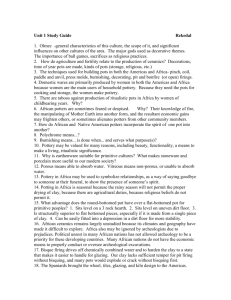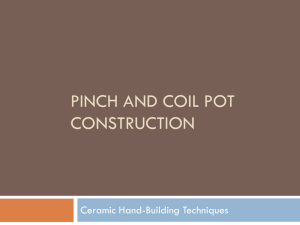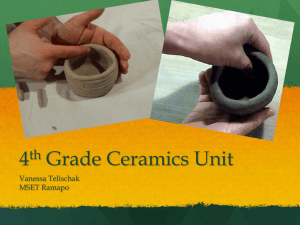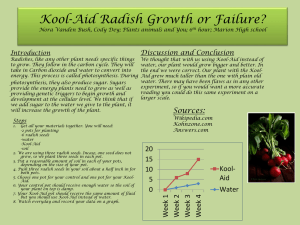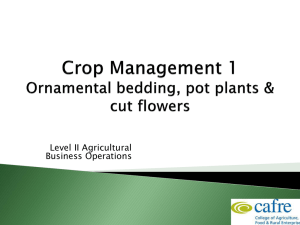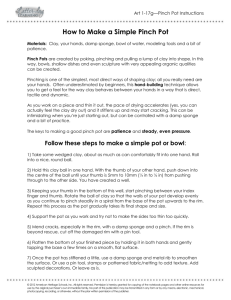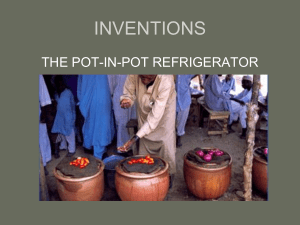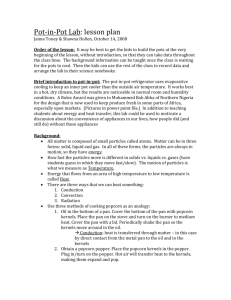History, care & use.pdf
advertisement
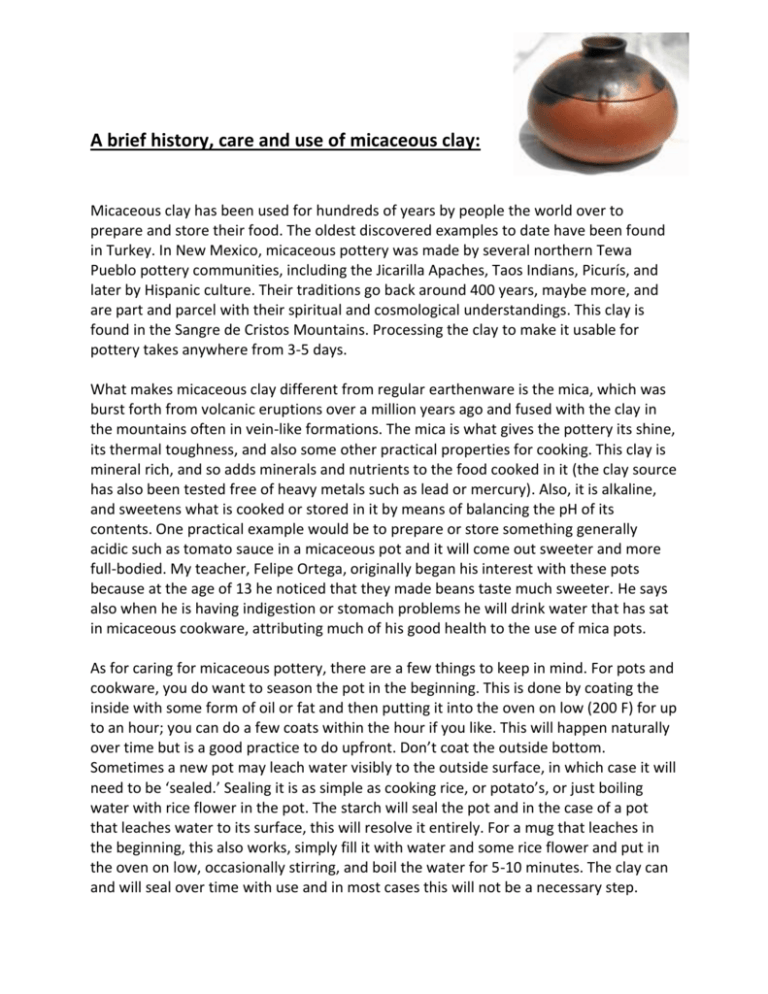
A brief history, care and use of micaceous clay: Micaceous clay has been used for hundreds of years by people the world over to prepare and store their food. The oldest discovered examples to date have been found in Turkey. In New Mexico, micaceous pottery was made by several northern Tewa Pueblo pottery communities, including the Jicarilla Apaches, Taos Indians, Picurís, and later by Hispanic culture. Their traditions go back around 400 years, maybe more, and are part and parcel with their spiritual and cosmological understandings. This clay is found in the Sangre de Cristos Mountains. Processing the clay to make it usable for pottery takes anywhere from 3-5 days. What makes micaceous clay different from regular earthenware is the mica, which was burst forth from volcanic eruptions over a million years ago and fused with the clay in the mountains often in vein-like formations. The mica is what gives the pottery its shine, its thermal toughness, and also some other practical properties for cooking. This clay is mineral rich, and so adds minerals and nutrients to the food cooked in it (the clay source has also been tested free of heavy metals such as lead or mercury). Also, it is alkaline, and sweetens what is cooked or stored in it by means of balancing the pH of its contents. One practical example would be to prepare or store something generally acidic such as tomato sauce in a micaceous pot and it will come out sweeter and more full-bodied. My teacher, Felipe Ortega, originally began his interest with these pots because at the age of 13 he noticed that they made beans taste much sweeter. He says also when he is having indigestion or stomach problems he will drink water that has sat in micaceous cookware, attributing much of his good health to the use of mica pots. As for caring for micaceous pottery, there are a few things to keep in mind. For pots and cookware, you do want to season the pot in the beginning. This is done by coating the inside with some form of oil or fat and then putting it into the oven on low (200 F) for up to an hour; you can do a few coats within the hour if you like. This will happen naturally over time but is a good practice to do upfront. Don’t coat the outside bottom. Sometimes a new pot may leach water visibly to the outside surface, in which case it will need to be ‘sealed.’ Sealing it is as simple as cooking rice, or potato’s, or just boiling water with rice flower in the pot. The starch will seal the pot and in the case of a pot that leaches water to its surface, this will resolve it entirely. For a mug that leaches in the beginning, this also works, simply fill it with water and some rice flower and put in the oven on low, occasionally stirring, and boil the water for 5-10 minutes. The clay can and will seal over time with use and in most cases this will not be a necessary step. These pots work similar to cast iron and will absorb or marinate, per se, over time with what is put in them. There are stories of cooks who have sold their restaurants and recipes but kept their micaceous pots that they had been using for years as they were the true secret to their delicious food. Hand-wash only. While it is perfectly fine to wash them with soap, don’t let them soak overnight with soapy water. It’s best to wash them with cloth or a sponge, but nothing too abrasive (i.e. – brillo pad/ steel wool) as this can wear away the finish over time. If things are sticking to the pot and you can’t get them off it is better in the long run to let the pot soak with water for a while or overnight and finish cleaning it later. Another trick to stuck food is to bring some water to a boil in the pot and then wash it again, this time it usually comes off almost by itself. These types of pots were traditionally used over open fire. They can be put on stove tops (electric, gas, or wood), over open flame, or in the oven; they are fire resistant obviously as they were fired at temperatures just over 1500 degrees Fahrenheit. Avoid rapid direct temperature changes, if you heat the pots up too fast, over time, they could develop cracks. You can put them in a pre-heated oven, however, as the body of the pot will be heating evenly. These are tough pots and can take a good amount of abuse but best practice is to heat the stove top with the pot. When the pot is full of food, it is best not to grab the handles directly but to grab under them and use them as supports, especially for larger pots. Best practice is to use plastic, nylon or wooden utensils, as metal can wear on the surface over time. One of the great benefits of these pots is that they hold heat, and thusly, their ambient heat helps to thoroughly cook what’s in them; this makes them great for slow cooking. Over the years they may take on cosmetic wear and tear, scratches, dings, etc., but you can minimalize this through proper care and use. The oldest mica pot I’ve eaten from was made in 1974 and is still in use as of 2014. By following these guidelines, your micaceous pot will be your kitchen companion, imparting delicious taste and the magnetic beauty of the clay to your meals and your kitchen, for a very long time. Enjoy! Brendan O’Brien 904 655 6667 potterybybrendan.com
